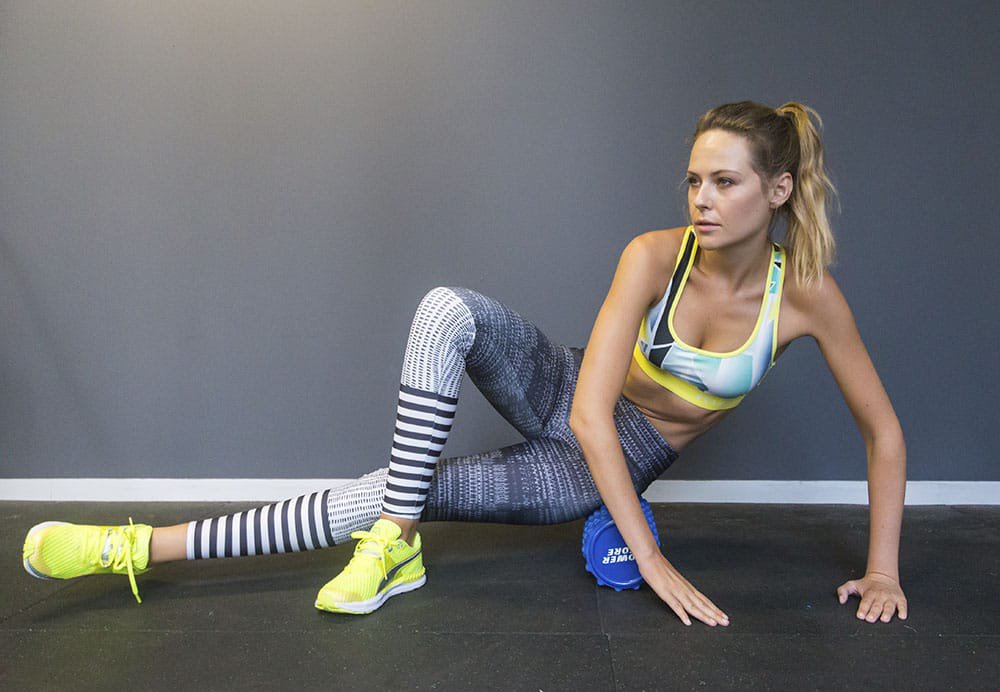Hip pain is a common injury that plagues many athletes, especially us runners. But determining what’s causing your pain can be tricky. If you’re experiencing hip pain, we’ve got everything you need to know about hip injuries, including how to treat and prevent them. But first, here’s a quick refresher on hip anatomy:
The hip is a basic ball-and-socket joint. The ball is the femoral head – a knob on the top of the thigh bone – and the socket is an indentation in the pelvic bone. There is cartilage lining the joint (called the labrum) and ligaments that attach the pelvic and thigh bones. Numerous muscles attach around the hip, too, moving the joint through the basic motions of flexion (bending), extension (extending the leg behind you), abduction (lifting the leg away from the body), adduction (moving the leg inward), internal rotation, and external rotation.
Identifying Hip Pain Symptoms
Pain in the front of the joint – where the leg attaches to the trunk – is typically caused by hip joint problems. You may also feel pain associated with a hip injury in the lower part of your glutes and the top of the back of your thigh. Other symptoms include the inability to move the leg at the hip, inability to put weight on one leg due to pain at the hip, or swelling around the joint. As runners, you may also experience pain in the hip joint only when running due to a hip injury.
RELATED: 7 Simple Exercises For Powerful Glutes
Common Causes of Hip Pain
The most common culprits of discomfort include hip flexor strains or hip flexor tendinitis, stress fractures, and osteoarthritis. Less commonly, labral (cartilage) tears may cause pain.
Hip flexors are a group of muscles that move the thigh forward and up. Strains (pulls) are often caused by a backward slippage of the foot. This may occur with one big slip or repetitive small slips while running on a slick surface, such as snow.
RELATED: 6 Stress Fracture Warning Signs
Tendinitis – which occurs when your psoas muscle (a deep hip muscle) is overused and pulls on a tendon that attaches it to the iliac bone, causing the tendon to become inflamed – is usually due to increased mileage, speed work, or hill work.
RELATED: Your Guide To Smashing Hills!
Pain on the outside of the hip is most commonly due to greater trochanteric bursitis. The greater trochanter is the protrusion where the thigh bone juts outward at the base of the neck (which connects the ball to the femur and is the site of hip stress fractures). A lubricating sac (or bursa) lies over the boney protrusion so that the surrounding muscles do not rub directly on the bone. The top region of the iliotibial (IT) band, known as the tensor fascia lata, is commonly involved in greater trochanteric bursitis.
Pain along the inside of the hip may be due to tendinitis or strain of the adductor muscles. Adductors (or inner thigh muscles) pull the leg inward as it is moving forward—the faster the movement, the greater the degree of adduction. Since footprints of a runner are almost single file as opposed to the side-by-side footprints of a walker, there is some degree of adduction occurring during running.
Pain in the inner hip and sometimes the front of the joint can be caused by osteitis pubis, sports hernias, infections, pubic stress fractures, or osteoarthritis.
Hip Pain Treatment
Persistent or worsening hip pain warrants a visit to your health care provider and possibly a sports medicine specialist. Some problems, particularly hip stress fractures, are commonly misdiagnosed due to the confusing presentation of symptoms.
A thorough evaluation is necessary and often includes X-rays and other studies, such as an MRI or bone scan. As with all injuries, the absence of pain does not mean that all is well. Strength and flexibility deficits must be addressed to allow a healthy return to running.
Tendinitis treatment includes decreasing training, applying ice, strengthening, and stretching. How much you decrease your training is based on the severity of your symptoms. If there is pain with walking, then cross train in a pool. Cycling, rowing machines, stair steppers, and elliptical trainers may also be used if they do not cause pain. In less severe cases, cut back on mileage by 25 to 50 percent and eliminate speed training and hill work.
Treatment for greater trochanteric bursitis includes stretching and strengthening your IT band, hip abductors, and gluteal muscles, all while avoiding running on banked surfaces. Applying ice to the painful area for 15 minutes, three to four times per day can help, too. A cortisone injection may be beneficial if your injury is severe. Worsening pain should raise suspicion for a stress fracture, in which case you should see your doctor right away.
For strains and tendinitis at the top of the hamstrings, treatment is the same as that used for hip flexor problems. Hamstring stretching and strengthening – such as side lunges, inward leg raises, and backward leg raises – is important. Deep tissue massage may also be beneficial, but in general, this is a difficult problem that usually takes a while to resolve.
Hip Pain Prevention
To prevent any hip injury, strengthening and stretching your hip flexors is key. And while stretching your hip flexors can be difficult, here are two that work well:
Lie on your back on the edge of a table or high bed, and drop your outside leg off the edge.
Lunge with your back leg fully extended. Lifrt arms up overhead and extend slightly backward if possible.
Adding leg lifts into your routine is an easy way to strengthen your hip flexors – you can add in weights or a resistance band to make this exercise harder. To maximize strength throughout the hip, do leg raises in each direction – back, forward, in, and out.
Issues in the hips are often related to weak glutes. Strengthening your gluteal muscles with squats and exercises like bridge pose can help. Finally, foam rolling daily will help keep your hip flexors loose and relaxed and less prone to injury.

